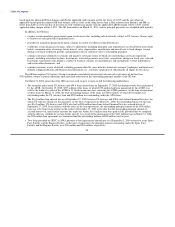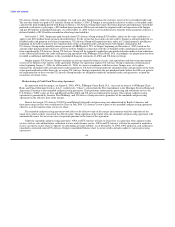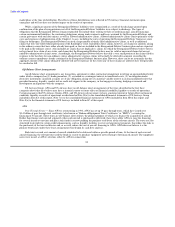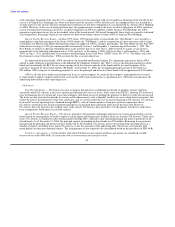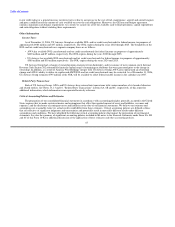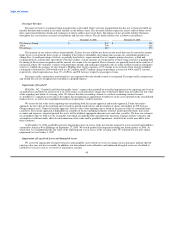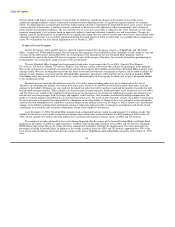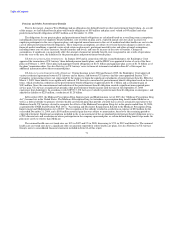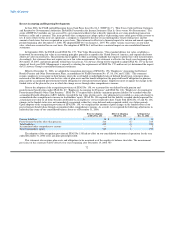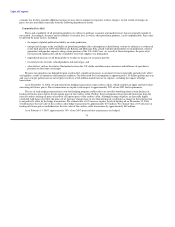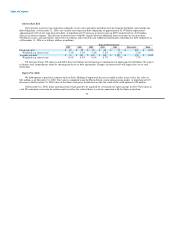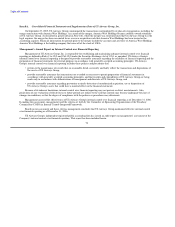US Airways 2006 Annual Report Download - page 71
Download and view the complete annual report
Please find page 71 of the 2006 US Airways annual report below. You can navigate through the pages in the report by either clicking on the pages listed below, or by using the keyword search tool below to find specific information within the annual report.
Table of Contents
Passenger Revenue
Passenger revenue is recognized when transportation is provided. Ticket sales for transportation that has not yet been provided are
initially deferred and recorded as air traffic liability on the balance sheet. The air traffic liability represents tickets sold for future travel
dates and estimated future refunds and exchanges of tickets sold for past travel dates. The balance in the air traffic liability fluctuates
throughout the year based on seasonal travel patterns and fare sale activity. The air traffic liability was as follows (in millions):
December 31, 2006 December 31, 2005
US Airways Group $ 847 $ 788
AWA 359 218
US Airways 487 570
The majority of our tickets sold are nonrefundable. Tickets that are sold but not flown on the travel date may be reused for another
flight, up to a year from the date of sale, or refunded, if the ticket is refundable, after taking into account any cancellation penalties or
change fees. A small percentage of tickets, or partially used tickets, expire unused. Due to complex pricing structures, refund and
exchange policies, and interline agreements with other airlines, certain amounts are recognized in revenue using estimates regarding both
the timing of the revenue recognition and the amount of revenue to be recognized. These estimates are generally based on the analysis of
our historical data. We routinely evaluate estimated future refunds and exchanges included in the air traffic liability based on subsequent
activity to validate the accuracy of our estimates. Holding other factors constant, a 10% change in our estimate of the amount refunded,
exchanged or forfeited for 2006 would result in a $12 million and $27 million change in passenger revenue for AWA and US Airways,
respectively, which represents less than 1% of AWA's and US Airways' respective passenger revenue.
Passenger traffic commissions and related fees are expensed when the related revenue is recognized. Passenger traffic commissions
and related fees not yet recognized are included as a prepaid expense.
Impairment of Goodwill
SFAS No. 142, "Goodwill and Other Intangible Assets" requires that goodwill be tested for impairment at the reporting unit level on
an annual basis and between annual tests if an event occurs or circumstances change that would more likely than not reduce the fair value
of the reporting unit below its carrying value. We believe that this accounting estimate is a critical accounting estimate because:
(1) goodwill is a significant asset and (2) the impact that recognizing an impairment would have on the asset reported on the consolidated
balance sheets, as well as the consolidated statement of operations, could be material.
We assess the fair value of the reporting unit considering both the income approach and market approach. Under the market
approach, the fair value of the reporting unit is based on quoted market prices and the number of shares outstanding for US Airways
Group common stock. Under the income approach, the fair value of the reporting unit is based on the present value of estimated future
cash flows. The income approach is dependent on a number of factors including estimates of future market growth trends, forecasted
revenues and expenses, expected periods the assets will be utilized, appropriate discount rates and other variables. We base our estimates
on assumptions that we believe to be reasonable, but which are unpredictable and inherently uncertain. Changes in these estimates and
assumptions could materially affect the determination of fair value and/or goodwill impairment. Actual future results may differ from
those estimates.
At December 31, 2006, goodwill represents the purchase price in excess of the net amount assigned to assets acquired and liabilities
assumed by America West Holdings on September 27, 2005. We tested goodwill for impairment during the fourth quarter of 2006. At
which time we concluded that the fair value of the reporting unit was in excess of the carrying value. We will perform our next annual
impairment test on October 1, 2007.
Impairment of Long-lived Assets and Intangible Assets
We assess the impairment of long-lived assets and intangible assets whenever events or changes in circumstances indicate that the
carrying value may not be recoverable. In addition, our international route authorities and trademark intangible assets are classified as
indefinite lived assets and are reviewed for impairment annually.
68


